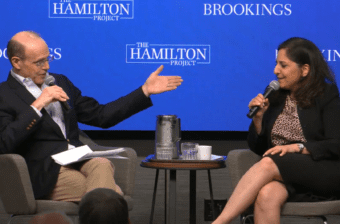The following e-book was published in conjunction with a 2017 joint Hamilton Project, LeanIn.Org, and Stanford Law School event, “Policies to Promote Women’s Economic Opportunity.”
Introduction
The U.S. economy will not operate at its full potential unless government and employers remove impediments to full participation by women in the labor market. The failure to address structural problems in labor markets, tax, and employment policy that women face does more than hold back their careers and aspirations for a better life. In fact, barriers to participation by women also act as brakes on the national economy, stifling the economy’s ability to grow. The lives and fortunes of women in the workplace affect us all.
The evidence for these arguments is strong. The evidence also speaks decisively for the proposals in this volume, backed by decades of research, which will allow labor markets to make the best use of women’s skills, and permit women, families, and the broader economy to prosper as a result.
Since the turn of the century, American women’s labor force participation has declined. Today, large gaps remain between men and women in the jobs they hold, the wages they earn, and their overall economic security. We don’t have all the answers to explain this recent trend. But we do know some of what limits American women’s labor market opportunities. It is inflexible rules at many workplaces, which require long hours and penalize the wages of women who must balance demands at home. It is the failure of the United States to adopt national policies on paid leave for mothers following the birth of their children. It is the choice women are forced to make between child care and paid employment, or between child care and educational success.
It is the majority of workers who lack access to paid sick leave in order to deal with their own or a family member’s health. These and other failures to address the conflicts between work and family impel many women to leave employment entirely. These problems are compounded when they become disabled, lose their spouses, and face economic insecurity late in life.
The U.S. economy does not have to function this way.
Instead, we can adopt evidence-based public policies that will provide better outcomes for women, make work pay, and help women restore control over their lives so they can meet their obligations and contribute to the economy amidst the conflicts of work and life. Public policy can do that. Making the optimal use of women’s talents and drive must become an active and urgent concern for those with a stake in America’s economic success.
Section One: Women and the Modern American Economy
Chapter 1: The Recent Decline in Women’s Labor Force Participation
by Sandra E. Black, Diane Whitmore Schanzenbach, Audrey Breitwieser
Abstract:
While women’s labor force participation has increased substantially in the U.S. over the second half of the 20th century, this growth has stagnated and reversed since 2000, with women’s labor force participation falling by 3.5 percentage points. This pattern persists across women of varying races and ethnicities, educational backgrounds, ages, and marital statuses, and for women with and without children alike. Interestingly, this decline seems to be moving directly against the trends observed in other major OECD economies. In order to facilitate economic growth in the United States, policies should be directed toward enabling and encouraging women to participate in the labor force. Learn more
Chapter 2: The Incomplete Progress of Women in the Labor Market
by Ryan Nunn, Megan Mumford
Abstract:
The gap between wages of men and women has fallen over the past several decades, reflecting women’s economic progress. Successive generations of women have obtained more education and received higher wages, entering a broader range of occupations that had previously been male-dominated. However, a significant gender wage gap remains. Occupational segregation, differences in academic specialization, difficulty in balancing work and household responsibilities, and wage discrimination—among many other factors—likely underlie much of the remaining gender wage gap.
Section Two: Policies to Support Women from Career through Retirement
Chapter 3: Modernizing U.S. Labor Standards for 21st-Century Families
by Bridget Ansel, Heather Boushey
Abstract:
Women now make up almost half the U.S. workforce. Despite the central role women play in the U.S. economy, our labor laws and institutions do little to address the various ways in which women are held back at work. This not only hampers women’s economic well-being, but also has implications for U.S. productivity, labor force participation, and economic growth. In this paper, we propose policies aimed at boosting women’s economic outcomes: paid family leave, fair scheduling, and combatting wage discrimination. We show how enacting carefully designed policies in these categories will better address the challenges of today’s labor force, enhance women’s economic outcomes, and provide benefits for the national economy.
Chapter 4: Making Work Pay Better Through an Expanded Earned Income Tax Credit
by Hilary Hoynes, Jesse Rothstein, Krista Ruffini
Abstract:
The Earned Income Tax Credit (EITC) is a refundable tax credit that promotes work. Research has shown that it also reduces poverty and improves health and education outcomes. The maximum credit for families with two or fewer children has remained flat in inflation-adjusted terms since 1996. Over the same period, earnings prospects have stagnated or diminished for many Americans, and prime-age employment rates have fallen. This paper proposes to build on the successes of the EITC with a ten percent across-the-board increase in the federal credit. This expansion would provide a meaningful offset to stagnating real wages, encourage more people to enter employment, lift approximately 600,000 individuals out of poverty, and improve health and education outcomes for millions of children.
Chapter 5: Tax Policies to Encourage Women’s Labor Force Participation
by Sara LaLumia
Abstract:
The current tax treatment of married couples reduces wives’ labor force participation and creates other inefficiencies. I propose a new second-earner deduction, equal to 15 percent of the earnings of a lower-earning spouse. The proposed deduction would raise the after-tax return to work for many wives, encouraging an increase in married women’s labor supply, and would reduce marriage penalties on average.
Chapter 6: Increasing the Economic Security of Older Women
by Jason Brown, Karen Dynan
Abstract:
Disability and widowhood are major drivers of economic insecurity for women later in life. To reduce the risk of economic insecurity among older women, we propose to allow Social Security beneficiaries to forgo some benefits when claiming to finance greater benefits in the event of widowhood, disability, or both. The proposed changes would be voluntary and self-financing.
Section Three: Policies to Address the Needs of Caregiving Women
Chapter 7: Expanding Access to Earned Sick Leave to Support Caregiving
by Nicole Maestas
Abstract:
The rapid growth of the older population in the United States will dramatically increase the need for elder care, most of which will be provided at home by family members. Supporting an older person sometimes comes at the cost of leaving the labor force, particularly for caregivers in jobs with an inflexible work schedule. This paper proposes a federal earned sick leave mandate guaranteeing one hour of flexible, multi-purpose sick leave for every 30 hours worked. By helping workers periodically adjust their work schedules to accommodate intermittent and urgent caregiving activities, paid sick leave would increase both home caregiving and employment, as fewer workers would be forced to choose between these activities. This policy would benefit women and low-income workers in particular, as they are more likely to have inflexible working conditions and can less afford to stop working in order to provide care.
Chapter 8: A National Paid Parental Leave Policy for the United States
by Chris J. Ruhm
Abstract:
Prior research indicates that entitlements to paid parental leave following the birth of a child provide substantial labor market and health benefits. Despite widespread public support for paid leave, the United States is almost alone in being without a national paid leave policy, although a number of states have adopted such programs. A national paid leave program is proposed here that is designed to promote gender equity through entitlements to 12 weeks of paid time off work for both mothers and fathers. It is modest in comparison to other countries’ programs in both duration and generosity; this is in recognition of the uncertainty involved in applying international experiences to the United States. Additional program elements include: job protection during the leave and broad eligibility to parents with minimal employment histories; a wage replacement rate of 75 percent for low earners and 50 percent at higher earnings, up to a maximum; financing through a stable stream of general revenues; administration through a new office established within the Social Security Administration; and careful evaluation of the program three to five years after initial implementation.
Chapter 9: Public Investments in Child Care
by Elizabeth U. Cascio
Abstract:
Child care is a necessity for working women with young children. Yet, the costs of high-quality center-based child care in the United States—particularly for children under age five—are prohibitively high for many families. In this proposal, I describe a multifaceted approach to child-care policy that reduces the financial burden of child care, encourages maternal employment, and supports child development. I propose to replace existing federal childcare tax policies with a single refundable federal child-care tax credit that is more generous to lower-income families and families with children under the age of five. To address child care quality, I propose investments in Quality Rating and Improvement Systems and in expansion of universal preschool for four-year-olds. State and local governments could pursue these investments on their own or with federal assistance.
Chapter 10: Helping Women to Succeed in Higher Education: Supporting Student-Parents with Child Care
by Bridget Terry Long
Abstract:
Women have surpassed men in college enrollment. This trend is particularly pronounced among nontraditional students, including part-time and older students—two groups that face significant challenges in higher education. For the 4.8 million college students who are parents, high-quality, reliable, and affordable child care is essential. I propose building on the Child Care Access Means Parents in School (CCAMPIS) Program to structure an institutional grant program that better supports the availability of high-quality child care for parents pursuing postsecondary credentials (student-parents). Compared with the existing federal program, the proposed program would be larger and better targeted to address the substantial needs of low-income student-parents. Moreover, by focusing on the role of postsecondary institutions, the proposal is designed to ensure that student-parents have access to high-quality child care options that will have long-term benefits for both the student-parent and their child. The program would encourage enrollment practices and educational investments that benefit the individual as well as the overall economy.



